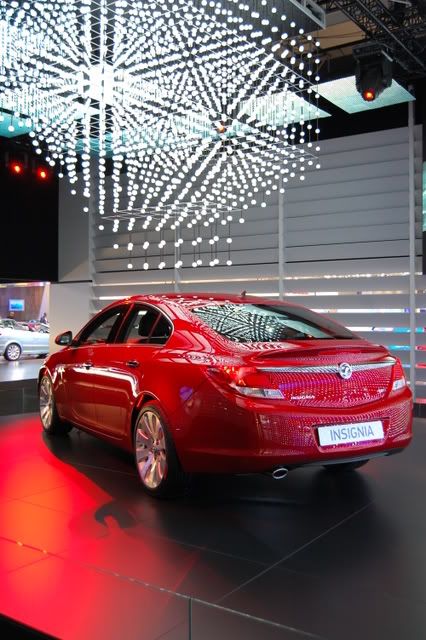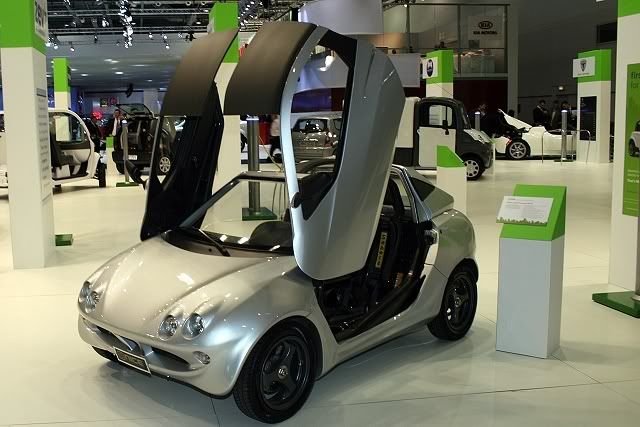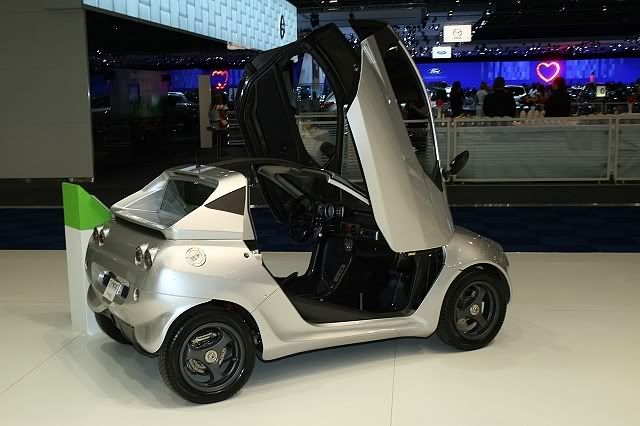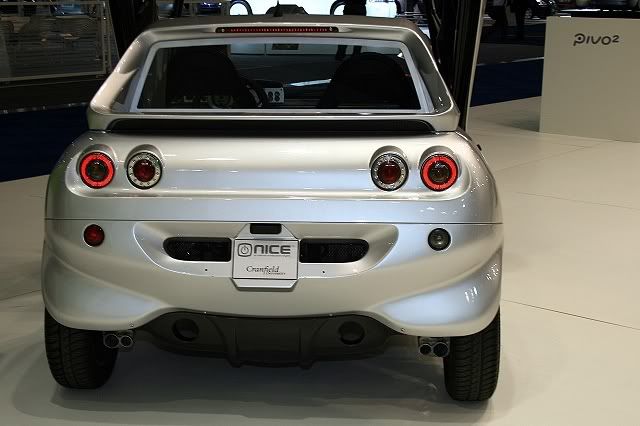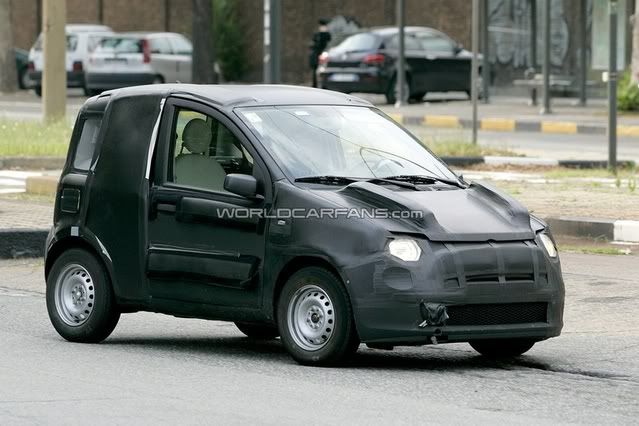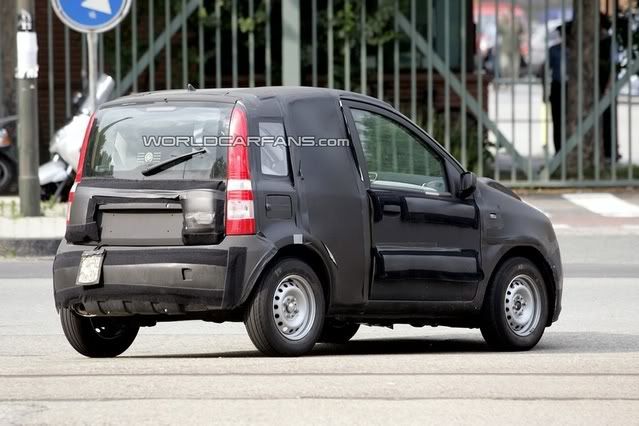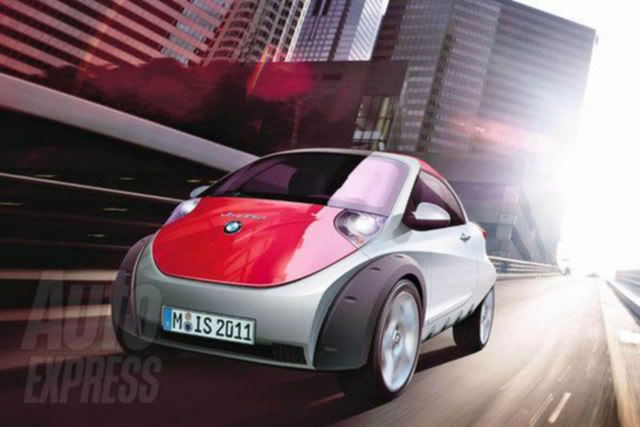Just a brief message to wish all of Tarmac's readers a great Christmas and as I'm unlikely to post again before January, a happy and productive new year.
Next year, I hope to offer you more regular posting, more discussion on cheap motoring and ecological and environmental motoring issues, many more motoring show reports, and even (if all goes well) the occasional relevant road tests.
I leave you in 2008 with one of my favourite static photographs of the year, and the closest I could get to an automotive Christmas tree...
NEC Motorcycle Show 2008
After visiting the British Motor Show earlier this year, an opportunity to pop along to the Motorcycle Show at the NEC wasn't to be missed. What was new in the world of motorcycling?
Bike shows are quite a departure from car shows. The crowds walking the halls are altogether more knowledgeable and tend to be enthusiastic about the subject, wheras car shows appeal more to the "day out" people who aren't necessarily car enthusiasts but go to the motor show each year with their kids for something to do. As such, the bike show is less publicised and a bit more "rough and ready" when you're there, with smaller stands, fewer manufacturers and less of a wow factor. For this reason, it's always good to have some interesting concepts or significant releases to make people feel like their day stalking the halls has been worthwhile.

All the main manufacturers had their full range on display. Kawasaki attracted the crowds to their new Ninja and a selection of their racing bikes with an array of attractive ladies in tight-fitting clothes, and Ducati attracted the crowds by painting their bikes bright red and by generally having a desirable line-up of bikes. Of particular note was the Desmosedici, which though not winning a MotoGP riders' title this year is still a gorgeous and brutally fast bike in road trim. If you don't need to travel quite so quickly, the latest version of Ducati's stalwart, the Monster, was on display, and for those who like to provide their own power, you can choose from a suspiciously expensive-looking mountain bike or racing bike which probably retail for the same price as the Monster.
There were other Italian marques at the show, notably Benelli with their striking Tornado sports bike, and for younger riders (or the young at heart) Cagiva was showing their new-to-the-UK Mito SP525, which contrary to the name is an updated version of their popular Mito 125. The diminutive machine remains a two stroke, and takes styling cues from the Desmosedici. With Aprilia missing, the Mito was holding it's own amongst a sea of 125cc four-strokes.
 Of said four-strokes, Yamaha were displaying their YZF-R125 which had been introduced at the show last year. They're already starting to appear on the roads in increasing numbers, which suggests that even in credit-crunch Britain people can't resist the hottest little bike on the market. In desirability, Honda's CBR125 just can't compete any more, though it does still offer an attractive proposition for smaller riders, especially with the disappearance of the CG125. The evergreen CG has been quietly replaced with the CBF125, both more modern and larger, and as such Honda's cheapest 125cc bike no longer appeals to this reporter. It's a pity the CG wasn't able to continue in the range with modifications to bring it within EURO-3 emissions regulations, but the new CBF is still a worthy beginner bike. It costs less than £2,000, it's not over-complicated, it's clean, and capable of significantly more than 100mpg.
Of said four-strokes, Yamaha were displaying their YZF-R125 which had been introduced at the show last year. They're already starting to appear on the roads in increasing numbers, which suggests that even in credit-crunch Britain people can't resist the hottest little bike on the market. In desirability, Honda's CBR125 just can't compete any more, though it does still offer an attractive proposition for smaller riders, especially with the disappearance of the CG125. The evergreen CG has been quietly replaced with the CBF125, both more modern and larger, and as such Honda's cheapest 125cc bike no longer appeals to this reporter. It's a pity the CG wasn't able to continue in the range with modifications to bring it within EURO-3 emissions regulations, but the new CBF is still a worthy beginner bike. It costs less than £2,000, it's not over-complicated, it's clean, and capable of significantly more than 100mpg.
Honda had their futuristic DN-01 at ground level this year to try out for size, and the styling still appeals, though I did hear other show-goers expressing their disapproval. Honda also had their genuinely futuristic V4 concept on display, which is more a clue towards future styling than anything else given that the wheels were seamless with the bodywork. Honda have a survey on their site to gauge opinion on the study.
 As for the rest of the show, little stood out. Royal Enfield had a good stand, with several Bullet Electra and Classic models. It's a range that really appeals for the more sedate aspects of motorcycling. The bikes are cheap, economical and have what could be described as adequate performance, allowing you to enjoy the open road without necessarily aiming for apexes and travelling at great speed. Custom bikes seemed to be popular this year, and they appeal for similar reasons, as well as some impressive engineering and paint jobs. KTM, Triumph, Harley Davidson and Eagle all had some interesting bikes, Eagle in particular drawing the crowds with some enormous cruisers and custom specials.
As for the rest of the show, little stood out. Royal Enfield had a good stand, with several Bullet Electra and Classic models. It's a range that really appeals for the more sedate aspects of motorcycling. The bikes are cheap, economical and have what could be described as adequate performance, allowing you to enjoy the open road without necessarily aiming for apexes and travelling at great speed. Custom bikes seemed to be popular this year, and they appeal for similar reasons, as well as some impressive engineering and paint jobs. KTM, Triumph, Harley Davidson and Eagle all had some interesting bikes, Eagle in particular drawing the crowds with some enormous cruisers and custom specials.
As I mentioned earlier, shows that lack the wow factor really need something else to make you feel like your day, and your £17 plus £8 for parking, has been worthwhile. The 2008 NEC Bike Show was a good day out, but compared to the impressive venue and £10 of the British Motor Show earlier this year, there is still a long way to go.
More photographs below. All photographs ©Tarmac 2008






Bike shows are quite a departure from car shows. The crowds walking the halls are altogether more knowledgeable and tend to be enthusiastic about the subject, wheras car shows appeal more to the "day out" people who aren't necessarily car enthusiasts but go to the motor show each year with their kids for something to do. As such, the bike show is less publicised and a bit more "rough and ready" when you're there, with smaller stands, fewer manufacturers and less of a wow factor. For this reason, it's always good to have some interesting concepts or significant releases to make people feel like their day stalking the halls has been worthwhile.

All the main manufacturers had their full range on display. Kawasaki attracted the crowds to their new Ninja and a selection of their racing bikes with an array of attractive ladies in tight-fitting clothes, and Ducati attracted the crowds by painting their bikes bright red and by generally having a desirable line-up of bikes. Of particular note was the Desmosedici, which though not winning a MotoGP riders' title this year is still a gorgeous and brutally fast bike in road trim. If you don't need to travel quite so quickly, the latest version of Ducati's stalwart, the Monster, was on display, and for those who like to provide their own power, you can choose from a suspiciously expensive-looking mountain bike or racing bike which probably retail for the same price as the Monster.
There were other Italian marques at the show, notably Benelli with their striking Tornado sports bike, and for younger riders (or the young at heart) Cagiva was showing their new-to-the-UK Mito SP525, which contrary to the name is an updated version of their popular Mito 125. The diminutive machine remains a two stroke, and takes styling cues from the Desmosedici. With Aprilia missing, the Mito was holding it's own amongst a sea of 125cc four-strokes.
 Of said four-strokes, Yamaha were displaying their YZF-R125 which had been introduced at the show last year. They're already starting to appear on the roads in increasing numbers, which suggests that even in credit-crunch Britain people can't resist the hottest little bike on the market. In desirability, Honda's CBR125 just can't compete any more, though it does still offer an attractive proposition for smaller riders, especially with the disappearance of the CG125. The evergreen CG has been quietly replaced with the CBF125, both more modern and larger, and as such Honda's cheapest 125cc bike no longer appeals to this reporter. It's a pity the CG wasn't able to continue in the range with modifications to bring it within EURO-3 emissions regulations, but the new CBF is still a worthy beginner bike. It costs less than £2,000, it's not over-complicated, it's clean, and capable of significantly more than 100mpg.
Of said four-strokes, Yamaha were displaying their YZF-R125 which had been introduced at the show last year. They're already starting to appear on the roads in increasing numbers, which suggests that even in credit-crunch Britain people can't resist the hottest little bike on the market. In desirability, Honda's CBR125 just can't compete any more, though it does still offer an attractive proposition for smaller riders, especially with the disappearance of the CG125. The evergreen CG has been quietly replaced with the CBF125, both more modern and larger, and as such Honda's cheapest 125cc bike no longer appeals to this reporter. It's a pity the CG wasn't able to continue in the range with modifications to bring it within EURO-3 emissions regulations, but the new CBF is still a worthy beginner bike. It costs less than £2,000, it's not over-complicated, it's clean, and capable of significantly more than 100mpg.Honda had their futuristic DN-01 at ground level this year to try out for size, and the styling still appeals, though I did hear other show-goers expressing their disapproval. Honda also had their genuinely futuristic V4 concept on display, which is more a clue towards future styling than anything else given that the wheels were seamless with the bodywork. Honda have a survey on their site to gauge opinion on the study.
 As for the rest of the show, little stood out. Royal Enfield had a good stand, with several Bullet Electra and Classic models. It's a range that really appeals for the more sedate aspects of motorcycling. The bikes are cheap, economical and have what could be described as adequate performance, allowing you to enjoy the open road without necessarily aiming for apexes and travelling at great speed. Custom bikes seemed to be popular this year, and they appeal for similar reasons, as well as some impressive engineering and paint jobs. KTM, Triumph, Harley Davidson and Eagle all had some interesting bikes, Eagle in particular drawing the crowds with some enormous cruisers and custom specials.
As for the rest of the show, little stood out. Royal Enfield had a good stand, with several Bullet Electra and Classic models. It's a range that really appeals for the more sedate aspects of motorcycling. The bikes are cheap, economical and have what could be described as adequate performance, allowing you to enjoy the open road without necessarily aiming for apexes and travelling at great speed. Custom bikes seemed to be popular this year, and they appeal for similar reasons, as well as some impressive engineering and paint jobs. KTM, Triumph, Harley Davidson and Eagle all had some interesting bikes, Eagle in particular drawing the crowds with some enormous cruisers and custom specials.As I mentioned earlier, shows that lack the wow factor really need something else to make you feel like your day, and your £17 plus £8 for parking, has been worthwhile. The 2008 NEC Bike Show was a good day out, but compared to the impressive venue and £10 of the British Motor Show earlier this year, there is still a long way to go.
More photographs below. All photographs ©Tarmac 2008






Bike hire hits London in 2010
Following the lead taken by cities like Paris and Barcelona, Transport for London has revealed plans for introducing a cycle hire scheme. The move is being used as a way of promoting healthy and environmentally friendly transport, and alleviating congestion both on roads and on the tube.
TfL plan to introduce 400 cycle stations with 10,500 docking points, and 6,000 bicycles up for hire. The high number of docking points should allow users to drop their bike off pretty much anywhere they like, and the scheme is aimed not just at residents and commuters, but also for the millions of tourists who visit the capital every year. A small poll on the TfL site reveals that commuting will still be the most popular single use for the bikes, but currently almost half the respondents will use the bikes for multiple activities.
I wouldn't normally cover non-car related stories on Tarmac, but as I'm soon to be a bicycle user myself, the news is particularly significant. Although I'm not a resident of London, the potential success of the scheme could open the floodgates for other cities around the country to launch similar initiatives, which would be great news. This is the sort of positive action councils should be taking in order to encourage people onto other methods of transport, rather than simply trying to discourage them from driving, as methods like congestion charging do.
The action in London is also a positive step to reducing congestion and emissions under their new mayor. After the huge legal battle previous Mayor Ken Livingstone has recently lost against Porsche, the sports car maker has donated the £375,000 payout to charity. Porsche argued that the proposed £25 a day charge was disproportionate and unfair, and were even able to prove that it would result in increased emissions in the capital. Maybe the cycle scheme should use Porsche bikes?...
TfL plan to introduce 400 cycle stations with 10,500 docking points, and 6,000 bicycles up for hire. The high number of docking points should allow users to drop their bike off pretty much anywhere they like, and the scheme is aimed not just at residents and commuters, but also for the millions of tourists who visit the capital every year. A small poll on the TfL site reveals that commuting will still be the most popular single use for the bikes, but currently almost half the respondents will use the bikes for multiple activities.
I wouldn't normally cover non-car related stories on Tarmac, but as I'm soon to be a bicycle user myself, the news is particularly significant. Although I'm not a resident of London, the potential success of the scheme could open the floodgates for other cities around the country to launch similar initiatives, which would be great news. This is the sort of positive action councils should be taking in order to encourage people onto other methods of transport, rather than simply trying to discourage them from driving, as methods like congestion charging do.
The action in London is also a positive step to reducing congestion and emissions under their new mayor. After the huge legal battle previous Mayor Ken Livingstone has recently lost against Porsche, the sports car maker has donated the £375,000 payout to charity. Porsche argued that the proposed £25 a day charge was disproportionate and unfair, and were even able to prove that it would result in increased emissions in the capital. Maybe the cycle scheme should use Porsche bikes?...
£1500, fun and 30mpg plus... what would you buy?
It's a good question, isn't it? Particularly if, like me, you happen to have that budget, and those requirements from a car. £1500 gets you a surprising amount these days, anything from tidy superminis, MPVs and third-hand family cars to classic roadsters, hot hatches and sports saloons. Some will make great runarounds or first cars and others fun weekend toys.
But, if you're like me (young, skint, and like a bit of fun from your car now and then) you might find your choice rather more limited. Sure, you can find plenty of old hot hatches at this price, but unfortunately many have been ragged to within an inch of their lives by now, and insurance is still very expensive even with a few years no-claims behind you. Such is the plight of the young driver.
However, hope is in store. There are still choices out there, if you look hard enough, that will provide you with fun and reliable motoring, but importantly, not emptying your wallet come renewal time or at the pumps. With fuel prices as they are, easily doing more than 30mpg is virtually essential nowadays. Below is a selection of cars that meet the above criteria. What would you buy?
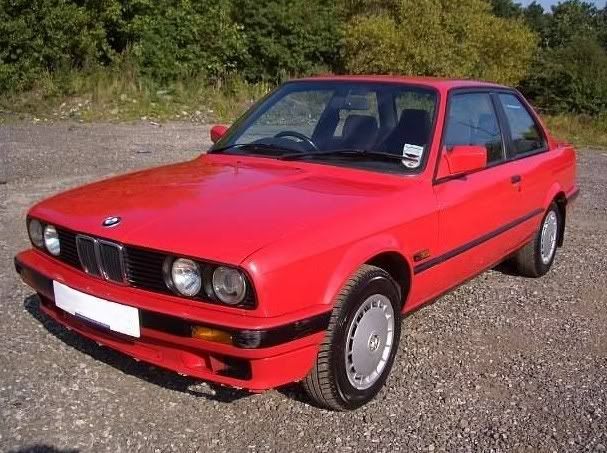 The E30 3-series is slowly becoming a collectors' item. Partly due to it being an important model for the marque, and partly to ensure the survival of original cars before they're all snapped up by the tuning brigade. The 316i and 318i aren't the fastest, but they are both cheap to run and the £1500 budget will get a model in very nice condition. A bit of rear-wheel drive fun to start the list.
The E30 3-series is slowly becoming a collectors' item. Partly due to it being an important model for the marque, and partly to ensure the survival of original cars before they're all snapped up by the tuning brigade. The 316i and 318i aren't the fastest, but they are both cheap to run and the £1500 budget will get a model in very nice condition. A bit of rear-wheel drive fun to start the list.
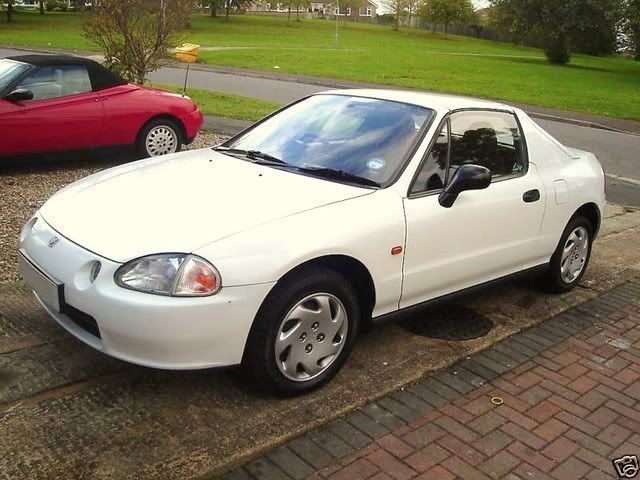 Having seen the success of Mazda's MX5, Honda decided to make their own sports car based on the Civic. It wasn't as light and loony as the model that preceded it, but it has it's own character and roof-out fun. The ESi has roughly 120bhp, does almost 40mpg and is much cheaper to insure than the screaming VTi.
Having seen the success of Mazda's MX5, Honda decided to make their own sports car based on the Civic. It wasn't as light and loony as the model that preceded it, but it has it's own character and roof-out fun. The ESi has roughly 120bhp, does almost 40mpg and is much cheaper to insure than the screaming VTi.
 A choice from way out at left-field here. You might not have expected to see a small 4x4 here - after all, they're not known for their great fuel economy or fun. Yet Honda were singing from a different hymn book with the HR-V - not only does it do at least 33mpg, but it's also supposed to be good fun to throw about.
A choice from way out at left-field here. You might not have expected to see a small 4x4 here - after all, they're not known for their great fuel economy or fun. Yet Honda were singing from a different hymn book with the HR-V - not only does it do at least 33mpg, but it's also supposed to be good fun to throw about.
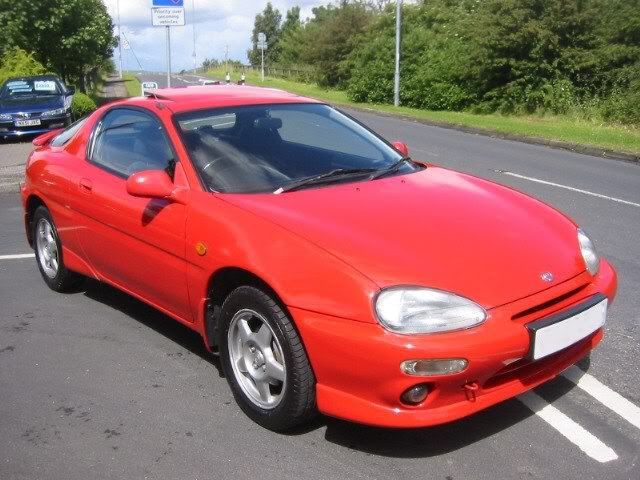 Mazda's coupe has managed to avoid the general public's consciousness thus far (thanks to more popular choices like Ford's Puma and Renualt's Megane Coupe), making it a great second-hand choice with low prices. The V6 engine sings yet manages mid-thirties mpg, and the cars seem generally well built and reliable.
Mazda's coupe has managed to avoid the general public's consciousness thus far (thanks to more popular choices like Ford's Puma and Renualt's Megane Coupe), making it a great second-hand choice with low prices. The V6 engine sings yet manages mid-thirties mpg, and the cars seem generally well built and reliable.
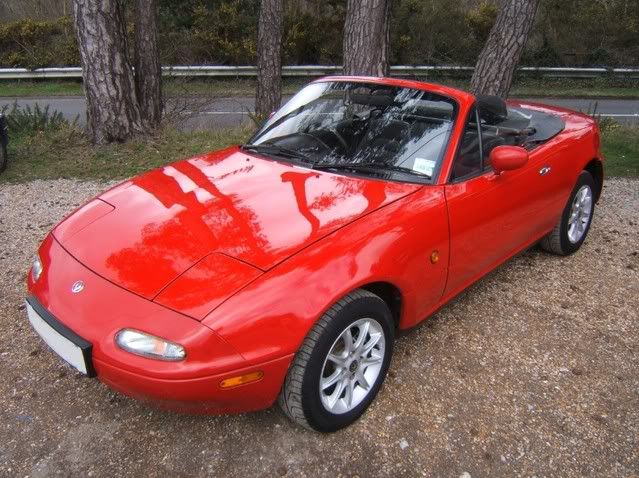 Another small Mazda, but one you've heard of this time. £1500 is remarkably little to buy a classic, but it's achievable with the MX5, and it's going to buy you a whole bundle of affordable fun. Ignore the hairdresser jibes - anyone who's driven one will tell you it's impossible to have perfect coiffure after five minutes with the hood down...
Another small Mazda, but one you've heard of this time. £1500 is remarkably little to buy a classic, but it's achievable with the MX5, and it's going to buy you a whole bundle of affordable fun. Ignore the hairdresser jibes - anyone who's driven one will tell you it's impossible to have perfect coiffure after five minutes with the hood down...
 You what? A Porsche for how much? It was always designed to be affordable and now you can buy one for pocket money. It isn't, as you might have heard, equipped with a van engine - it was an Audi engine that was tuned for use in the 924 and detuned for use in a VW van. Owners report 30mpg, and £1500 should get a nice one.
You what? A Porsche for how much? It was always designed to be affordable and now you can buy one for pocket money. It isn't, as you might have heard, equipped with a van engine - it was an Audi engine that was tuned for use in the 924 and detuned for use in a VW van. Owners report 30mpg, and £1500 should get a nice one.
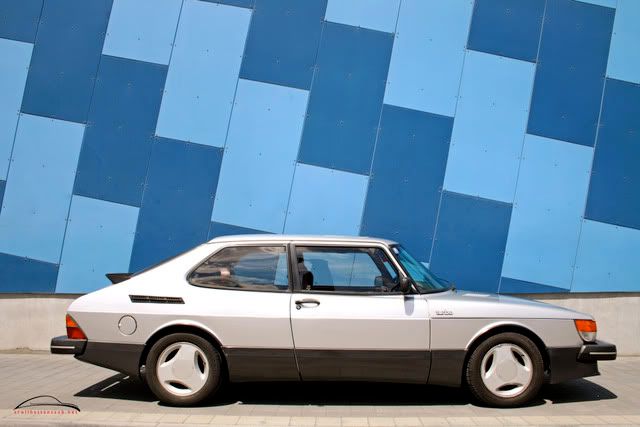 Turbo lag and torque steer. Right, now the stereotypes are out of the way, we can appreciate the car's unusual styling, great seats, bucketfulls of character and great performance. Not only that, but many insurers consider it a classic now, so you might be able to benefit from cheap classic insurance.
Turbo lag and torque steer. Right, now the stereotypes are out of the way, we can appreciate the car's unusual styling, great seats, bucketfulls of character and great performance. Not only that, but many insurers consider it a classic now, so you might be able to benefit from cheap classic insurance.
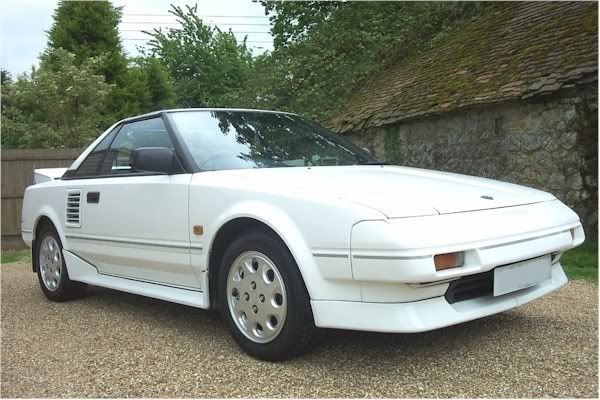 Rumor has it that the MR2 project was initially developed with Lotus, but Mazda took the project on fully when Lotus had financial issues and abandoned their share. So if you squint a bit, you're looking at an 80s Lotus Elise. Maybe. Either way, it's a brilliant drivers car which does mid-30s mpg. You may have to look hard for one untainted by rust, however.
Rumor has it that the MR2 project was initially developed with Lotus, but Mazda took the project on fully when Lotus had financial issues and abandoned their share. So if you squint a bit, you're looking at an 80s Lotus Elise. Maybe. Either way, it's a brilliant drivers car which does mid-30s mpg. You may have to look hard for one untainted by rust, however.
 Even less known than the Mazda MX-3, and arguably not as special, but with 40mpg easily achievable it has it's own merit. And of course, being a Toyota, it'll last for ever, and ever, and ever. It enjoys a very low insurance group as well, and should be fun, if not up to Ford Puma levels.
Even less known than the Mazda MX-3, and arguably not as special, but with 40mpg easily achievable it has it's own merit. And of course, being a Toyota, it'll last for ever, and ever, and ever. It enjoys a very low insurance group as well, and should be fun, if not up to Ford Puma levels.
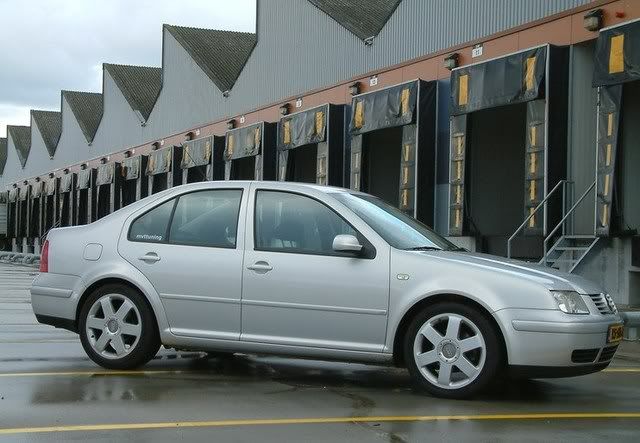 Although a small saloon seems a bit incongruous next to small sports cars, coupes and hatches - especially a diesel one - the Bora represents brilliant value for money. It's cheaper than the equivalent Golf both to buy and insure, yet shares the same great engines and build. The diesels get an easy 50mpg and can be tuned very easily for much more power and torque.
Although a small saloon seems a bit incongruous next to small sports cars, coupes and hatches - especially a diesel one - the Bora represents brilliant value for money. It's cheaper than the equivalent Golf both to buy and insure, yet shares the same great engines and build. The diesels get an easy 50mpg and can be tuned very easily for much more power and torque.
 My final suggestion is, undoubtably, a classic. If you want to spend £1500 on one, do it now because they're unlikely to stay at that price as they become more scarce and more popular for restoration. Manages 35mpg and faster to 60mph than the standard mk4 Golf GTI. Cheap to insure on classic insurance, too.
My final suggestion is, undoubtably, a classic. If you want to spend £1500 on one, do it now because they're unlikely to stay at that price as they become more scarce and more popular for restoration. Manages 35mpg and faster to 60mph than the standard mk4 Golf GTI. Cheap to insure on classic insurance, too.
An eclectic mix then, and perhaps a bit more interesting than your average hot hatch, yet likely to provide many miles of reliable, economical and fun motoring. If you're lucky, you may even find a little practicality to add to the mix. £1500 really does get you a lot of car.
But, if you're like me (young, skint, and like a bit of fun from your car now and then) you might find your choice rather more limited. Sure, you can find plenty of old hot hatches at this price, but unfortunately many have been ragged to within an inch of their lives by now, and insurance is still very expensive even with a few years no-claims behind you. Such is the plight of the young driver.
However, hope is in store. There are still choices out there, if you look hard enough, that will provide you with fun and reliable motoring, but importantly, not emptying your wallet come renewal time or at the pumps. With fuel prices as they are, easily doing more than 30mpg is virtually essential nowadays. Below is a selection of cars that meet the above criteria. What would you buy?
BMW 316i/318i (E30)
 The E30 3-series is slowly becoming a collectors' item. Partly due to it being an important model for the marque, and partly to ensure the survival of original cars before they're all snapped up by the tuning brigade. The 316i and 318i aren't the fastest, but they are both cheap to run and the £1500 budget will get a model in very nice condition. A bit of rear-wheel drive fun to start the list.
The E30 3-series is slowly becoming a collectors' item. Partly due to it being an important model for the marque, and partly to ensure the survival of original cars before they're all snapped up by the tuning brigade. The 316i and 318i aren't the fastest, but they are both cheap to run and the £1500 budget will get a model in very nice condition. A bit of rear-wheel drive fun to start the list.Honda CRX ESi (3rd gen)
 Having seen the success of Mazda's MX5, Honda decided to make their own sports car based on the Civic. It wasn't as light and loony as the model that preceded it, but it has it's own character and roof-out fun. The ESi has roughly 120bhp, does almost 40mpg and is much cheaper to insure than the screaming VTi.
Having seen the success of Mazda's MX5, Honda decided to make their own sports car based on the Civic. It wasn't as light and loony as the model that preceded it, but it has it's own character and roof-out fun. The ESi has roughly 120bhp, does almost 40mpg and is much cheaper to insure than the screaming VTi.Honda HR-V
 A choice from way out at left-field here. You might not have expected to see a small 4x4 here - after all, they're not known for their great fuel economy or fun. Yet Honda were singing from a different hymn book with the HR-V - not only does it do at least 33mpg, but it's also supposed to be good fun to throw about.
A choice from way out at left-field here. You might not have expected to see a small 4x4 here - after all, they're not known for their great fuel economy or fun. Yet Honda were singing from a different hymn book with the HR-V - not only does it do at least 33mpg, but it's also supposed to be good fun to throw about.Mazda MX-3 V6
 Mazda's coupe has managed to avoid the general public's consciousness thus far (thanks to more popular choices like Ford's Puma and Renualt's Megane Coupe), making it a great second-hand choice with low prices. The V6 engine sings yet manages mid-thirties mpg, and the cars seem generally well built and reliable.
Mazda's coupe has managed to avoid the general public's consciousness thus far (thanks to more popular choices like Ford's Puma and Renualt's Megane Coupe), making it a great second-hand choice with low prices. The V6 engine sings yet manages mid-thirties mpg, and the cars seem generally well built and reliable.Mazda MX-5 mk1
 Another small Mazda, but one you've heard of this time. £1500 is remarkably little to buy a classic, but it's achievable with the MX5, and it's going to buy you a whole bundle of affordable fun. Ignore the hairdresser jibes - anyone who's driven one will tell you it's impossible to have perfect coiffure after five minutes with the hood down...
Another small Mazda, but one you've heard of this time. £1500 is remarkably little to buy a classic, but it's achievable with the MX5, and it's going to buy you a whole bundle of affordable fun. Ignore the hairdresser jibes - anyone who's driven one will tell you it's impossible to have perfect coiffure after five minutes with the hood down...Porsche 924
 You what? A Porsche for how much? It was always designed to be affordable and now you can buy one for pocket money. It isn't, as you might have heard, equipped with a van engine - it was an Audi engine that was tuned for use in the 924 and detuned for use in a VW van. Owners report 30mpg, and £1500 should get a nice one.
You what? A Porsche for how much? It was always designed to be affordable and now you can buy one for pocket money. It isn't, as you might have heard, equipped with a van engine - it was an Audi engine that was tuned for use in the 924 and detuned for use in a VW van. Owners report 30mpg, and £1500 should get a nice one.Saab 900 T16
 Turbo lag and torque steer. Right, now the stereotypes are out of the way, we can appreciate the car's unusual styling, great seats, bucketfulls of character and great performance. Not only that, but many insurers consider it a classic now, so you might be able to benefit from cheap classic insurance.
Turbo lag and torque steer. Right, now the stereotypes are out of the way, we can appreciate the car's unusual styling, great seats, bucketfulls of character and great performance. Not only that, but many insurers consider it a classic now, so you might be able to benefit from cheap classic insurance.Toyota MR2 mk1
 Rumor has it that the MR2 project was initially developed with Lotus, but Mazda took the project on fully when Lotus had financial issues and abandoned their share. So if you squint a bit, you're looking at an 80s Lotus Elise. Maybe. Either way, it's a brilliant drivers car which does mid-30s mpg. You may have to look hard for one untainted by rust, however.
Rumor has it that the MR2 project was initially developed with Lotus, but Mazda took the project on fully when Lotus had financial issues and abandoned their share. So if you squint a bit, you're looking at an 80s Lotus Elise. Maybe. Either way, it's a brilliant drivers car which does mid-30s mpg. You may have to look hard for one untainted by rust, however.Toyota Paseo
 Even less known than the Mazda MX-3, and arguably not as special, but with 40mpg easily achievable it has it's own merit. And of course, being a Toyota, it'll last for ever, and ever, and ever. It enjoys a very low insurance group as well, and should be fun, if not up to Ford Puma levels.
Even less known than the Mazda MX-3, and arguably not as special, but with 40mpg easily achievable it has it's own merit. And of course, being a Toyota, it'll last for ever, and ever, and ever. It enjoys a very low insurance group as well, and should be fun, if not up to Ford Puma levels.Volkswagen Bora Tdi
 Although a small saloon seems a bit incongruous next to small sports cars, coupes and hatches - especially a diesel one - the Bora represents brilliant value for money. It's cheaper than the equivalent Golf both to buy and insure, yet shares the same great engines and build. The diesels get an easy 50mpg and can be tuned very easily for much more power and torque.
Although a small saloon seems a bit incongruous next to small sports cars, coupes and hatches - especially a diesel one - the Bora represents brilliant value for money. It's cheaper than the equivalent Golf both to buy and insure, yet shares the same great engines and build. The diesels get an easy 50mpg and can be tuned very easily for much more power and torque.Volkswagen Golf GTI mk1
 My final suggestion is, undoubtably, a classic. If you want to spend £1500 on one, do it now because they're unlikely to stay at that price as they become more scarce and more popular for restoration. Manages 35mpg and faster to 60mph than the standard mk4 Golf GTI. Cheap to insure on classic insurance, too.
My final suggestion is, undoubtably, a classic. If you want to spend £1500 on one, do it now because they're unlikely to stay at that price as they become more scarce and more popular for restoration. Manages 35mpg and faster to 60mph than the standard mk4 Golf GTI. Cheap to insure on classic insurance, too.An eclectic mix then, and perhaps a bit more interesting than your average hot hatch, yet likely to provide many miles of reliable, economical and fun motoring. If you're lucky, you may even find a little practicality to add to the mix. £1500 really does get you a lot of car.
Toyota iQ sports car on the way?
Intriguing rumours brought via Carscoop and Auto Motor und Sport today - that of apparent Toyota plans to show a concept study of a roadster based on the iQ city car at the Tokyo Motor Show around this time next year.
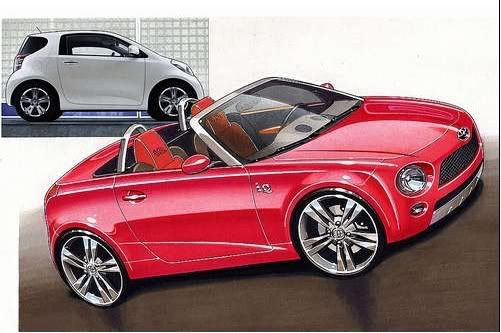
Image: Auto Motor und Sport
Early news indeed, so as of yet it's best to take the information with a pinch of salt, but it's promising nonetheless. The car would be perfectly placed to take up the gap in the market left after the tiny Smart Roadster departed and would prove a competitive rival to the Daihatsu Copen, the only other tiny sports car on the market at the moment.
Like the Copen, the iQ "Spider", as it's likely to be called, would be front-wheel drive, using the 1.0l and 1.3l engines and powertrain of the city car. This also means the car could potentially use the 1.4l diesel pencilled in for the regular iQ.
The regular iQ is due on sale January 2009 from around £10,000.
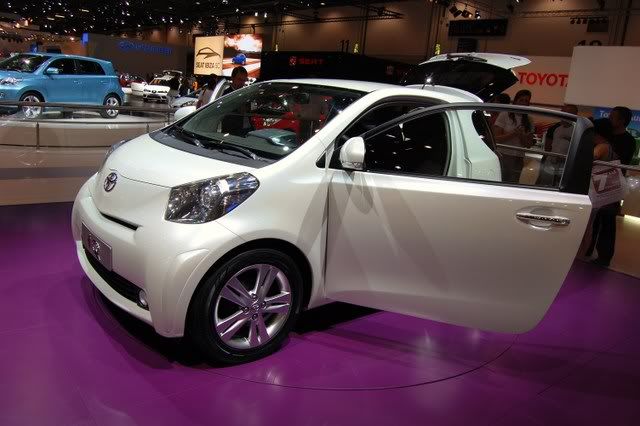
Image: ©Tarmac 2008

Image: Auto Motor und Sport
Early news indeed, so as of yet it's best to take the information with a pinch of salt, but it's promising nonetheless. The car would be perfectly placed to take up the gap in the market left after the tiny Smart Roadster departed and would prove a competitive rival to the Daihatsu Copen, the only other tiny sports car on the market at the moment.
Like the Copen, the iQ "Spider", as it's likely to be called, would be front-wheel drive, using the 1.0l and 1.3l engines and powertrain of the city car. This also means the car could potentially use the 1.4l diesel pencilled in for the regular iQ.
The regular iQ is due on sale January 2009 from around £10,000.

Image: ©Tarmac 2008
RAC: Scrap cars over 18 years old?
For a body that is often found fighting for the rights of the motorist and the car itself, the RAC's subsiduary, the RAC Foundation, has just released a confusing report suggesting that cars older than 18 years should be be scrapped in an attempt to "clean up" the roads. 18 years ago was the general time that the majority of cars started being fitted with catalytic converters. First impressions seem to suggest that cars older than this, then, are "dirty".
Whilst the RAC is not suggesting by any means that all cars older than this should immediately be destroyed, the report is still worrying, in that a body such as the RAC has a voice that can be heard by the government. The government aren't known for the subtlety by which they execute ideas, so I'm sure I'm not the only petrolhead who has images of a bill being passed through the Commons making all cars made before 1990 illegal.
Much of the RAC's report, available here (.pfd file) makes sense, but they worryingly refer to the scrapping plans increasing demand for new cars. This, in my eyes, has a few problems.
Firstly, the sort of people who own cars this old are either people who consider them classics, and therefore have deliberately bought them instead of buying a newer car, and those who struggle to afford even a car half that age so buy an older car through sheer necessity. Consumers in the first group are likely to be better equipped to keep their cars, under grounds that they're likely to be well-maintained and not too "dirty" anyway. Even if they do end up having to go to the scrapper, they might be in more of a position to afford something newer. Consumers in the second group might not be so lucky. Even with the small financial incentives that will be offered should any sort of scheme go ahead, they may not be able to reasonably afford a newer car. Many of either group might struggle to afford a new car, which is what the scheme is incentivising.
Secondly, the RAC keep referring to pollution as the CO2 figure (a trend echoed by the government). CO2 is directly proportional to fuel efficiency, so a car made in 1990 that does 30mpg will be producing roughly the same CO2 as one that's been made in 2008. The RAC provide figures showing that average CO2 has decreased by 16.4% since 1997, but this is much more indicative of the trend towards diesels than it is the trend for less polluting cars. And diesels produce very different particulates than the petrol engined cars that were more prolific back in 1990 anyway.
If we're to compare like-for-like, a 1990 BMW 318i should do around 35mpg in normal useage (and capable of much more), judging by various owners' reports found around the internet. The model that followed (91-98) did... 35mpg. The following model did a whopping... erm, 35mpg. The latest model (05-) does 38mpg according to official figures. Only the very latest version released this year, thanks to BMW's Efficient Dynamics program, climbs significantly to 47mpg (though it remains to be seen whether this is achievable in day-to-day use). The bottom line is that the CO2 rating will have stayed roughly the same for a good 17 years.
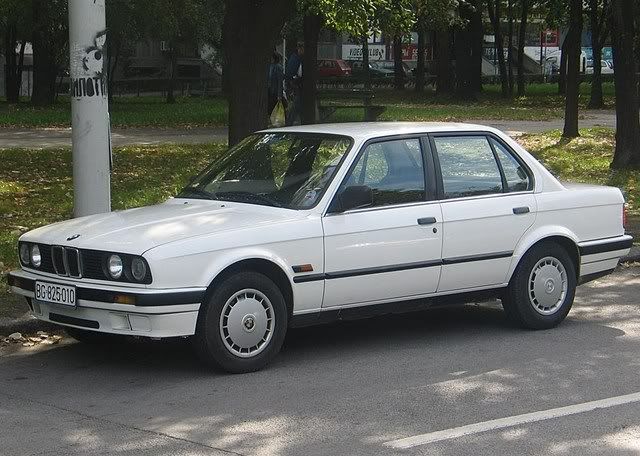
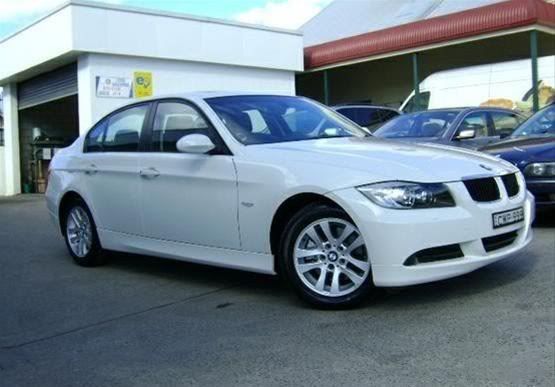
Old: 35mpg; New: only 3mpg better
This brings me onto the third point - that a car that's been well engineered in the first place (like the early 3-series above) and well maintained throughout its life will likely be kinder to the environment than many badly engineered and maintained vehicles half it's age. Not to mention that subsequent users aren't adding to the global carbon footprint by buying used, wheras new buyers are each contributing to the share of CO2 that the production of their car has caused, before the key has even been turned for the first time. Now obviously, it's unrealistic to assume that we should stop buying new cars to cut down on global CO2, but at the same time it's clear that scrapping anything older than 18 years is the answer either.
I'd personally be suggesting that pollution from any age of car could be reduced by additional driver training to enable people to extract the maximum efficiency from their chosen vehicles, but that's another subject for another day.
If you're the owner of an older car in the UK I wouldn't get worried just yet, but don't let that stop you thinking of some good excuses either...
Whilst the RAC is not suggesting by any means that all cars older than this should immediately be destroyed, the report is still worrying, in that a body such as the RAC has a voice that can be heard by the government. The government aren't known for the subtlety by which they execute ideas, so I'm sure I'm not the only petrolhead who has images of a bill being passed through the Commons making all cars made before 1990 illegal.
Much of the RAC's report, available here (.pfd file) makes sense, but they worryingly refer to the scrapping plans increasing demand for new cars. This, in my eyes, has a few problems.
Firstly, the sort of people who own cars this old are either people who consider them classics, and therefore have deliberately bought them instead of buying a newer car, and those who struggle to afford even a car half that age so buy an older car through sheer necessity. Consumers in the first group are likely to be better equipped to keep their cars, under grounds that they're likely to be well-maintained and not too "dirty" anyway. Even if they do end up having to go to the scrapper, they might be in more of a position to afford something newer. Consumers in the second group might not be so lucky. Even with the small financial incentives that will be offered should any sort of scheme go ahead, they may not be able to reasonably afford a newer car. Many of either group might struggle to afford a new car, which is what the scheme is incentivising.
Secondly, the RAC keep referring to pollution as the CO2 figure (a trend echoed by the government). CO2 is directly proportional to fuel efficiency, so a car made in 1990 that does 30mpg will be producing roughly the same CO2 as one that's been made in 2008. The RAC provide figures showing that average CO2 has decreased by 16.4% since 1997, but this is much more indicative of the trend towards diesels than it is the trend for less polluting cars. And diesels produce very different particulates than the petrol engined cars that were more prolific back in 1990 anyway.
If we're to compare like-for-like, a 1990 BMW 318i should do around 35mpg in normal useage (and capable of much more), judging by various owners' reports found around the internet. The model that followed (91-98) did... 35mpg. The following model did a whopping... erm, 35mpg. The latest model (05-) does 38mpg according to official figures. Only the very latest version released this year, thanks to BMW's Efficient Dynamics program, climbs significantly to 47mpg (though it remains to be seen whether this is achievable in day-to-day use). The bottom line is that the CO2 rating will have stayed roughly the same for a good 17 years.


Old: 35mpg; New: only 3mpg better
This brings me onto the third point - that a car that's been well engineered in the first place (like the early 3-series above) and well maintained throughout its life will likely be kinder to the environment than many badly engineered and maintained vehicles half it's age. Not to mention that subsequent users aren't adding to the global carbon footprint by buying used, wheras new buyers are each contributing to the share of CO2 that the production of their car has caused, before the key has even been turned for the first time. Now obviously, it's unrealistic to assume that we should stop buying new cars to cut down on global CO2, but at the same time it's clear that scrapping anything older than 18 years is the answer either.
I'd personally be suggesting that pollution from any age of car could be reduced by additional driver training to enable people to extract the maximum efficiency from their chosen vehicles, but that's another subject for another day.
If you're the owner of an older car in the UK I wouldn't get worried just yet, but don't let that stop you thinking of some good excuses either...
British International Motor Show 2008
Webmaster's comment: Apologies if you're reading this in Feedburner and the images are breaking up the text. The article makes much more sense if you read it using my original post.
So, now that the show is all done and dusted for another year, I finally get around to writing that Motor Show report I promised. Overall it was a fairly good show, with enough significant new car launches to cause excitement, such as the new Ford Fiesta and Vauxhall Insignia, as well as plenty of other interesting stands and a variety of things to do when you got bored of walking around the halls.
 I'll begin with the Insignia, as that's where I began my walk around the halls. Vauxhall had a large number of cars and it was just as well because they were attracting a lot of attention. It's not hard to see why, because as medium sized family cars go, it's a very attractive one, better looking in my opinion than the new Mondeo, which looks messy in comparison. There isn't a great deal of difference in the look between the hatch and the saloon versions, but then this brings the preference down to what you want from the car, rather than which looks better. The interior seems very well built and also classy in a way we never saw from the Vectra, and at first glace reminded me of the Honda Accord, but with a more colourful use of plastics. Engines of note included the twin-turbo V6 all-wheel drive option, which is apparently faster around the Nürburgring than the Astra VXR.
I'll begin with the Insignia, as that's where I began my walk around the halls. Vauxhall had a large number of cars and it was just as well because they were attracting a lot of attention. It's not hard to see why, because as medium sized family cars go, it's a very attractive one, better looking in my opinion than the new Mondeo, which looks messy in comparison. There isn't a great deal of difference in the look between the hatch and the saloon versions, but then this brings the preference down to what you want from the car, rather than which looks better. The interior seems very well built and also classy in a way we never saw from the Vectra, and at first glace reminded me of the Honda Accord, but with a more colourful use of plastics. Engines of note included the twin-turbo V6 all-wheel drive option, which is apparently faster around the Nürburgring than the Astra VXR.
Vauxhall also had a rather pretty concept vehicle on their stand, the Opel FLEXtreme, which looked about Astra-sized, had suicide back doors (as is popular these days) and a compartment in the rear bumper that stored two Segways. Perhaps design cues will be on a future Astra. As part of GM, Vauxhall was surrounded by other GM brands. Hummer was disp laying a concept vehicle that could easily be a model below the H3 to compete with hardcore Land Rover Defenders, and Caddilac was showing the sharp-looking CTS concept, which looks like a coupe version of the BLS. Saab also had a concept, the 9-X BioHybrid, which doesn't appear too different from the 9-X concept of 2001 but has a new green engine and some fantastic looking turbine-blade wheels. Saab also had their new soft-roader, the 9-4X, in concept form. The Chevrolet stand was fairly uninteresting except for the Camaro concept, though now that Chevy are producing the car you wonder why they didn't bring a production model over for show.
laying a concept vehicle that could easily be a model below the H3 to compete with hardcore Land Rover Defenders, and Caddilac was showing the sharp-looking CTS concept, which looks like a coupe version of the BLS. Saab also had a concept, the 9-X BioHybrid, which doesn't appear too different from the 9-X concept of 2001 but has a new green engine and some fantastic looking turbine-blade wheels. Saab also had their new soft-roader, the 9-4X, in concept form. The Chevrolet stand was fairly uninteresting except for the Camaro concept, though now that Chevy are producing the car you wonder why they didn't bring a production model over for show.
 Next to Saab was the non-GM Kia, who'd actually made quite an effort and had a fairly large stand. Unusually far back but certainly not out of the spotlight stood the Kia Kee, a bright green V6 coupe concept featuring what could be many future design details, and sending out a clear message that Kia means business now and isn't prepared to be seen as an unexciting manufacturer. Taking pride of place at the front of the stand were a selection of other concepts, the eco_cee'd (almost production ready), the ex_cee'd, which is a pretty cabriolet version of the normal cee'd, and a trio of Soul concept vehicles. The Soul 'Burner' is a kind of street racer's version of the tall small car with matt paint and red accents, the 'Diva' a 'bling'd' out shiny one with gold wheels, and the 'Searcher' which looked more like an outdoors pursuit car.
Next to Saab was the non-GM Kia, who'd actually made quite an effort and had a fairly large stand. Unusually far back but certainly not out of the spotlight stood the Kia Kee, a bright green V6 coupe concept featuring what could be many future design details, and sending out a clear message that Kia means business now and isn't prepared to be seen as an unexciting manufacturer. Taking pride of place at the front of the stand were a selection of other concepts, the eco_cee'd (almost production ready), the ex_cee'd, which is a pretty cabriolet version of the normal cee'd, and a trio of Soul concept vehicles. The Soul 'Burner' is a kind of street racer's version of the tall small car with matt paint and red accents, the 'Diva' a 'bling'd' out shiny one with gold wheels, and the 'Searcher' which looked more like an outdoors pursuit car.
A short hop past the eco vehicles (I'll come to them later) found me at Nissan where the impressive GT-R was making it's UK debut. If you've seen Top Gear or played Gran Turismo 5 Prologue you'll know it's performance credentials, but it was interesting to see it in the flesh, along with a cutaway version of the car exposing it's technology to all. GT-R and an irrelevant to the UK electric powered Cube excepted, the Nissan stand had nothing to keep me interested so I walked to their partner Renault, where my eye was caught by two beautiful concepts, one a Laguna Coupe in pearlescent white (which if it makes production will be the be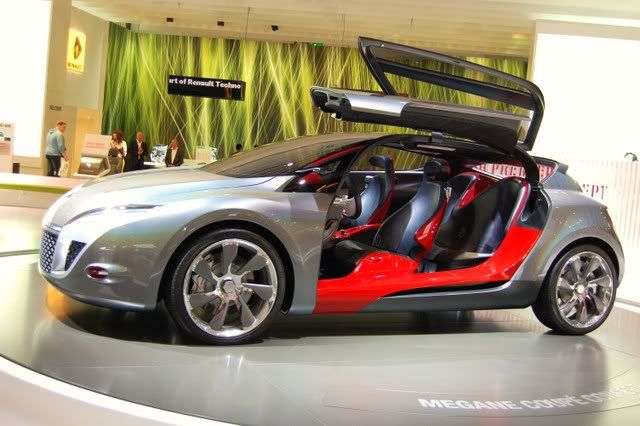 st looking French car since the Peugeot 406 Coupe ten years ago), and the eye-catching Megane Coupe Concept. This featured two-part doors, where the glass hinged upwards in a gullwing fashion, and then the main body of the door followed suit, supported by a single huge hinge at the back of the door, allowing complete access to the funky cockpit. The good news about this car is that the next Megane will be heavily based on the styling of this concept. Renault was also displaying the Megane R26.R, which has recently set the fastest Nürburgring lap time of any hot hatch, at 8m'17s.
st looking French car since the Peugeot 406 Coupe ten years ago), and the eye-catching Megane Coupe Concept. This featured two-part doors, where the glass hinged upwards in a gullwing fashion, and then the main body of the door followed suit, supported by a single huge hinge at the back of the door, allowing complete access to the funky cockpit. The good news about this car is that the next Megane will be heavily based on the styling of this concept. Renault was also displaying the Megane R26.R, which has recently set the fastest Nürburgring lap time of any hot hatch, at 8m'17s.
Across the hall were Mazda, who had the usuall array of RX-8s and MX-5s and Mazda3s, as well as the excellent Mazda2 (one of which was being held aloft by paper cranes, another in new Mazdaspeed form) and a few examples of their new 6, which looks as sleek as it does in pictures. It actually looks quite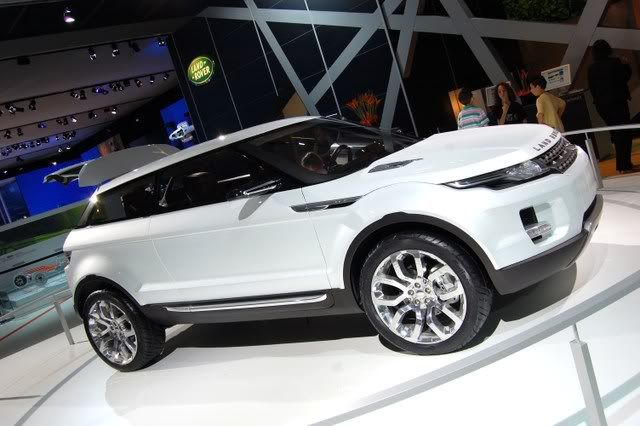 similar to the Insignia. At the back on a stage was the agressive and flowing Furai, with it's papery swoops lit up by LED lights and wearing a racing livery. In the centre of the hall were perfect original examples of the first generation Mazda MX-5 and the curvy RX-7. Opposite were the Jaguar and Land Rover stands. Jaguar didn't have anything particularly interesting to display but it was nice to see the XF up close, and Land Rover had the sleek LRX next to a pumped-up version of the Defender.
similar to the Insignia. At the back on a stage was the agressive and flowing Furai, with it's papery swoops lit up by LED lights and wearing a racing livery. In the centre of the hall were perfect original examples of the first generation Mazda MX-5 and the curvy RX-7. Opposite were the Jaguar and Land Rover stands. Jaguar didn't have anything particularly interesting to display but it was nice to see the XF up close, and Land Rover had the sleek LRX next to a pumped-up version of the Defender.
The Ford area was predictably massive, with a row of new Fiestas taking centre stage, plenty of Mondeos, a Formula Ford on the wall, and a bright Lamborghini-green new Focus RS right in the middle attracting admiring grunts from people in baseball caps. With almost 300bhp going through the front tyres, it'll be exciting at the very least. The best looking version of the Fiesta was actually the Econetic low-emissions version they had on display, because the blue paint scheme suited it a lot better than some of the awful choices on the other cars. A quick sit inside revealed it was certainly better quality than the previous model and very well equipped. The gearchange is mounted high like the Mazda2 it's based on but space in the rear didn't look too special, even compared with my own ten year-old Fiesta. It's sure to be a good car, but on balance I'd prefer the Mazda2.
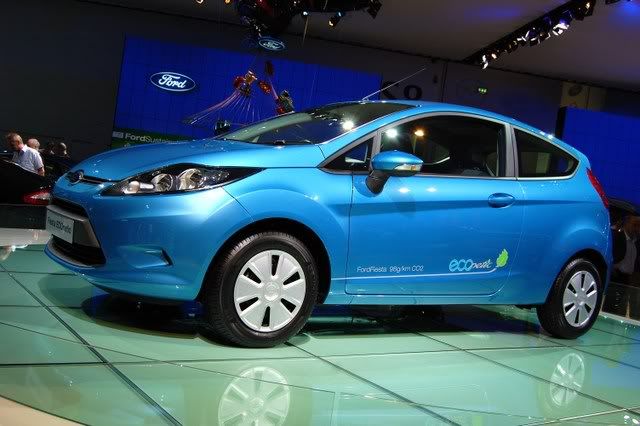
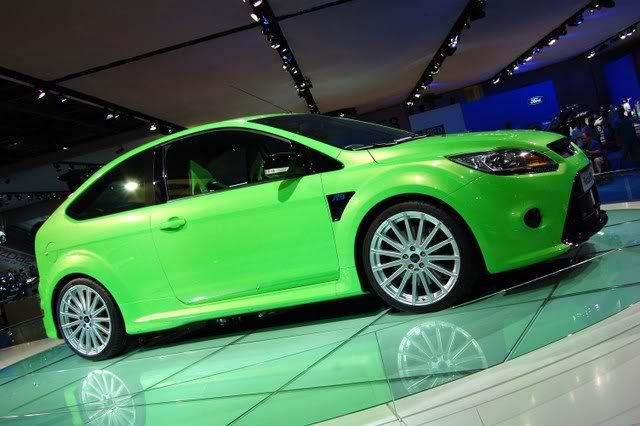 I also took a quick look inside the Kuga, Ford's soft-roader, to compare it with the VW Tiguan I'd had a closer look at a month or so back. Personally I prefer the VW still, but the Ford rep who joined me inside the car did a good job of highlighting some great features the Kuga has, such as a three-pin plug in the back for accessories. Much better than a fag lighter. Alas, he couldn't make the speech-recognition function understand his commands though.
I also took a quick look inside the Kuga, Ford's soft-roader, to compare it with the VW Tiguan I'd had a closer look at a month or so back. Personally I prefer the VW still, but the Ford rep who joined me inside the car did a good job of highlighting some great features the Kuga has, such as a three-pin plug in the back for accessories. Much better than a fag lighter. Alas, he couldn't make the speech-recognition function understand his commands though.
That was it for the first hall. Honda started the next, with a few new Accords being overshadowed by the sexy OSM (Open Study Model) concept, which in produ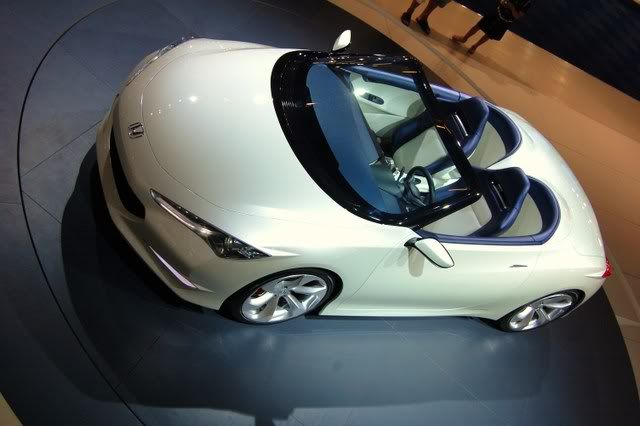 ction form will be replacing the S2000 as Honda's sports car. The display model was front wheel drive and used a hybrid powertrain. Displaying the same characteristics was the Honda CR-Z, a spiritual successor to the old CRX and sporting the same split rear screen and looking every inch the agressive small coupe. On the upper stand was the FCX fuel cell vehicle, getting virtually no attention from the visitors. Hiding it isn't the best way to introduce the concept to the people.
ction form will be replacing the S2000 as Honda's sports car. The display model was front wheel drive and used a hybrid powertrain. Displaying the same characteristics was the Honda CR-Z, a spiritual successor to the old CRX and sporting the same split rear screen and looking every inch the agressive small coupe. On the upper stand was the FCX fuel cell vehicle, getting virtually no attention from the visitors. Hiding it isn't the best way to introduce the concept to the people.
Suzuki had cars hidden away too, but not important ones. A special edition Jimny sat next to a Swift rally car and a couple of motorcycles, but out front were the Kizashi and A-star concepts, a sleek, powerful fastback and a small city car respectively. Next door, Lexus had their LF-A sports car on display next to their worthy but dull range of big saloons and SUVs. BRABUS and Mercedes-Benz were attracting more attention, making best use of V12 bombshell saloons and AMG models.
Toyota was once again pushing the Hybrid message, with the hyped-up Prius sitting uneasily near three off-roaders, one of which makes use of a 4.5 litre V8 engine, albeit a diesel. Mixed messages for potential Toyota customers. Also near the Prius was the Hybrid I concept, which looked just like a future Prius fitted with features that will never make production. The mid-engined Aygo Crazy was also on the stand, but isn't as interesting in person as it is in magazines. A disappointing range. Subaru also disappointed, with just a diesel Legacy and a slightly hotter Impreza WRX 'S' remotely getting any attention.
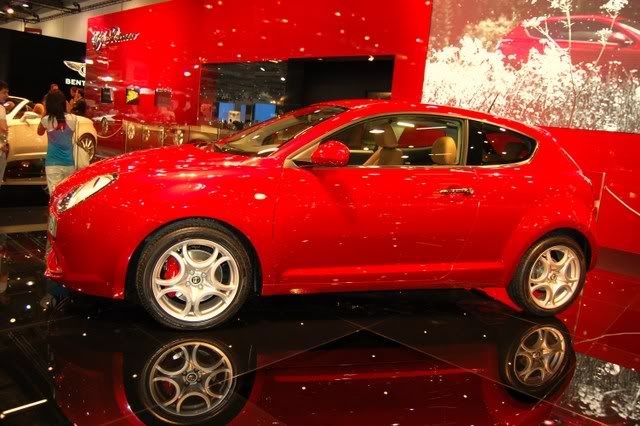
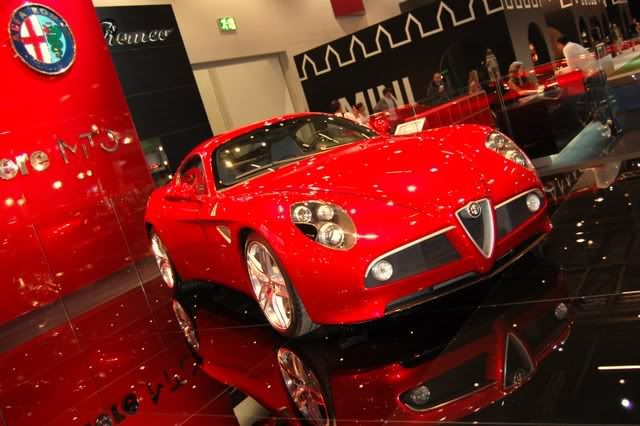 Alfa Romeo however had a fantastic array of cars and the stand was packed on both days I visited. Whatever shade of red and whatever lighting they'd chosen, was making the cars look absolutely stunning, glinting like rubies and attracting visitors like magpies. Pride of place was reserved to the two 8Cs (a coupe and a cabriolet), a Brera Spider and a Mito. Examples of most of their range were available to sit and poke around in, so I made a bee-line for the Mito, here in left-hand drive. It looks much better in real life than it does in pictures, so that was my first worry dispelled. The interior seems well made, very nicely designed and typically sporty. The leather seats were gorgeous and all the controls (pedals, gearshift) seemed light. I'll endeavour to get a road test once the model is in showrooms.
Alfa Romeo however had a fantastic array of cars and the stand was packed on both days I visited. Whatever shade of red and whatever lighting they'd chosen, was making the cars look absolutely stunning, glinting like rubies and attracting visitors like magpies. Pride of place was reserved to the two 8Cs (a coupe and a cabriolet), a Brera Spider and a Mito. Examples of most of their range were available to sit and poke around in, so I made a bee-line for the Mito, here in left-hand drive. It looks much better in real life than it does in pictures, so that was my first worry dispelled. The interior seems well made, very nicely designed and typically sporty. The leather seats were gorgeous and all the controls (pedals, gearshift) seemed light. I'll endeavour to get a road test once the model is in showrooms.
SEAT had a large range of cars, with the Ibiza SC being the main attraction, but I didn't try it out for size. Looks good enough, but isn't particularly exciting. The Leon Cupra next to th eir touring car, painted in white, looked the business though, and was attracting a number of admiring glances. Despite being a 5-door it's certainly one of the better looking hot hatchbacks available. At the other side of the stand were a line of three"Ecomotive" models, a Leon, old Ibiza and a Sharan. It seems every manufacturer is cashing in on the bandwagon. Apart from looking very basic and painted a crisp white they didn't show any signs of being any different from the regular models. They do apparently have low emissions though, so maybe I'm just being cynical.
eir touring car, painted in white, looked the business though, and was attracting a number of admiring glances. Despite being a 5-door it's certainly one of the better looking hot hatchbacks available. At the other side of the stand were a line of three"Ecomotive" models, a Leon, old Ibiza and a Sharan. It seems every manufacturer is cashing in on the bandwagon. Apart from looking very basic and painted a crisp white they didn't show any signs of being any different from the regular models. They do apparently have low emissions though, so maybe I'm just being cynical.
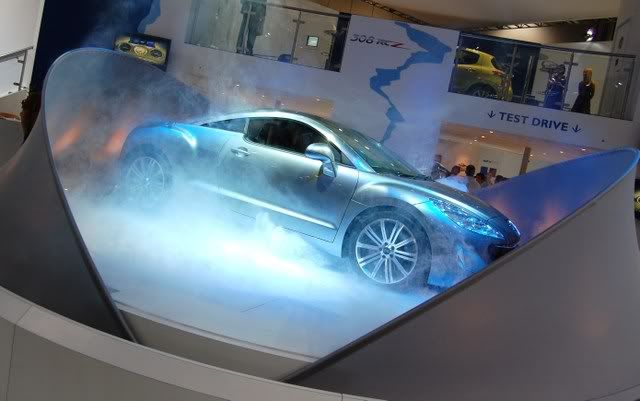 Hyundai had a new coupe on display, as well as an i10 ice cream van with a pretty show girl handing out free ice lollies, and a decent looking i30, but otherwise nothing of note. Peugeot had even less on offer, save for the 308 RCZ which they were "unveiling" all week to draw a bit of attention to their range populated by ugly and boring passenger cars. No amount of Le Mans cars, tarted up 207s and track cars can give a halo effect to that range.
Hyundai had a new coupe on display, as well as an i10 ice cream van with a pretty show girl handing out free ice lollies, and a decent looking i30, but otherwise nothing of note. Peugeot had even less on offer, save for the 308 RCZ which they were "unveiling" all week to draw a bit of attention to their range populated by ugly and boring passenger cars. No amount of Le Mans cars, tarted up 207s and track cars can give a halo effect to that range.
I'll skip the supercars in the Sunday Times enclosure as you can read plenty about them elsewhere (most likely in the Times), but as far as sports cars Lotus' new Evora was drawing the crowds. Not as pretty as the Elise but a good looking sports car nonetheless. Lotus' stand, as usual, was populated by people of increased physical stature trying to feed themselves into Elises and Exiges and failing miserably.
After all this, there was much to do outdoors, if you could bear the queues. There was an off-road mountain style display with Land Rovers in police livery, and a VXR tent pumping out loud music the whole time and generally being as brash as the cars themselves. Honda had their own action arena that I neglected to go to for time and money reasons, but I did have a go at the Mazda Zoom-Zoom challenge, not wanting to miss the opportunity to try a Mazda2 and an MX-5 on a mini track. After an hour queueing you only get about five minutes of driving but even that is enough to confirm that the 2 feels very much like an MX-5 - there's some strong family DNA running through it. The gearshift in both is sweet and the steering accurate and with good feel for both cars. Pedal feel is lacking in both, though I'm sure with more miles you wouldn't notice. If you can't afford an MX-5, get a 2, you won't be missing out on much! Hopefully I'll get a longer drive in a 2 soon.
There were plenty of motorhomes on display which brought into mind images of epic Stateside road trips, and an array of commercial vehicles courtesy of What Van? Magazine giving them their own space. Like many of the manufacturer's standard cars, these were available to test drive.
So what of the no-shows? I was disappointed by the lack of Fiat, BMW, VW, Audi and Volvo most noticably, and it was a pity to not see Daihatsu there either, given that their parent company Toyota was there and yet had a pretty dull range. These manufacturers all have some great cars and some fairly recent releases (the VW Scirocco being a noticeable abscence) and although I'm sure they have their reasons for not attending, it would not surprise me if some customers shun these brands in favour of their rivals. Certainly, the Insignia was a high enough quality product to make people think twice about buying a 3-series or Audi A4.
Stand of the show definitely goes to Alfa Romeo. They're a brand on resurgence and the popularity of the stand can only be a good thing, even if it's made one extra person decide to get a 159 instead of a BMW. The Mito will certainly give MINI something to worry about. Car of the show for me was probably the Honda CR-Z, as it's exactly the sort of car I want to see, sporty, economical, small. As far as more mainstream cars go, the Insignia and new Fiesta will soon be everywhere but they're certainly going to be very good cars.
And so you've reached the end of Motor Show 2008. I'll soon be doing an electric/eco cars supplement so keep your eyes peeled!
All photographs ©Tarmac 2008
So, now that the show is all done and dusted for another year, I finally get around to writing that Motor Show report I promised. Overall it was a fairly good show, with enough significant new car launches to cause excitement, such as the new Ford Fiesta and Vauxhall Insignia, as well as plenty of other interesting stands and a variety of things to do when you got bored of walking around the halls.
 I'll begin with the Insignia, as that's where I began my walk around the halls. Vauxhall had a large number of cars and it was just as well because they were attracting a lot of attention. It's not hard to see why, because as medium sized family cars go, it's a very attractive one, better looking in my opinion than the new Mondeo, which looks messy in comparison. There isn't a great deal of difference in the look between the hatch and the saloon versions, but then this brings the preference down to what you want from the car, rather than which looks better. The interior seems very well built and also classy in a way we never saw from the Vectra, and at first glace reminded me of the Honda Accord, but with a more colourful use of plastics. Engines of note included the twin-turbo V6 all-wheel drive option, which is apparently faster around the Nürburgring than the Astra VXR.
I'll begin with the Insignia, as that's where I began my walk around the halls. Vauxhall had a large number of cars and it was just as well because they were attracting a lot of attention. It's not hard to see why, because as medium sized family cars go, it's a very attractive one, better looking in my opinion than the new Mondeo, which looks messy in comparison. There isn't a great deal of difference in the look between the hatch and the saloon versions, but then this brings the preference down to what you want from the car, rather than which looks better. The interior seems very well built and also classy in a way we never saw from the Vectra, and at first glace reminded me of the Honda Accord, but with a more colourful use of plastics. Engines of note included the twin-turbo V6 all-wheel drive option, which is apparently faster around the Nürburgring than the Astra VXR.Vauxhall also had a rather pretty concept vehicle on their stand, the Opel FLEXtreme, which looked about Astra-sized, had suicide back doors (as is popular these days) and a compartment in the rear bumper that stored two Segways. Perhaps design cues will be on a future Astra. As part of GM, Vauxhall was surrounded by other GM brands. Hummer was disp
 laying a concept vehicle that could easily be a model below the H3 to compete with hardcore Land Rover Defenders, and Caddilac was showing the sharp-looking CTS concept, which looks like a coupe version of the BLS. Saab also had a concept, the 9-X BioHybrid, which doesn't appear too different from the 9-X concept of 2001 but has a new green engine and some fantastic looking turbine-blade wheels. Saab also had their new soft-roader, the 9-4X, in concept form. The Chevrolet stand was fairly uninteresting except for the Camaro concept, though now that Chevy are producing the car you wonder why they didn't bring a production model over for show.
laying a concept vehicle that could easily be a model below the H3 to compete with hardcore Land Rover Defenders, and Caddilac was showing the sharp-looking CTS concept, which looks like a coupe version of the BLS. Saab also had a concept, the 9-X BioHybrid, which doesn't appear too different from the 9-X concept of 2001 but has a new green engine and some fantastic looking turbine-blade wheels. Saab also had their new soft-roader, the 9-4X, in concept form. The Chevrolet stand was fairly uninteresting except for the Camaro concept, though now that Chevy are producing the car you wonder why they didn't bring a production model over for show. Next to Saab was the non-GM Kia, who'd actually made quite an effort and had a fairly large stand. Unusually far back but certainly not out of the spotlight stood the Kia Kee, a bright green V6 coupe concept featuring what could be many future design details, and sending out a clear message that Kia means business now and isn't prepared to be seen as an unexciting manufacturer. Taking pride of place at the front of the stand were a selection of other concepts, the eco_cee'd (almost production ready), the ex_cee'd, which is a pretty cabriolet version of the normal cee'd, and a trio of Soul concept vehicles. The Soul 'Burner' is a kind of street racer's version of the tall small car with matt paint and red accents, the 'Diva' a 'bling'd' out shiny one with gold wheels, and the 'Searcher' which looked more like an outdoors pursuit car.
Next to Saab was the non-GM Kia, who'd actually made quite an effort and had a fairly large stand. Unusually far back but certainly not out of the spotlight stood the Kia Kee, a bright green V6 coupe concept featuring what could be many future design details, and sending out a clear message that Kia means business now and isn't prepared to be seen as an unexciting manufacturer. Taking pride of place at the front of the stand were a selection of other concepts, the eco_cee'd (almost production ready), the ex_cee'd, which is a pretty cabriolet version of the normal cee'd, and a trio of Soul concept vehicles. The Soul 'Burner' is a kind of street racer's version of the tall small car with matt paint and red accents, the 'Diva' a 'bling'd' out shiny one with gold wheels, and the 'Searcher' which looked more like an outdoors pursuit car.A short hop past the eco vehicles (I'll come to them later) found me at Nissan where the impressive GT-R was making it's UK debut. If you've seen Top Gear or played Gran Turismo 5 Prologue you'll know it's performance credentials, but it was interesting to see it in the flesh, along with a cutaway version of the car exposing it's technology to all. GT-R and an irrelevant to the UK electric powered Cube excepted, the Nissan stand had nothing to keep me interested so I walked to their partner Renault, where my eye was caught by two beautiful concepts, one a Laguna Coupe in pearlescent white (which if it makes production will be the be
 st looking French car since the Peugeot 406 Coupe ten years ago), and the eye-catching Megane Coupe Concept. This featured two-part doors, where the glass hinged upwards in a gullwing fashion, and then the main body of the door followed suit, supported by a single huge hinge at the back of the door, allowing complete access to the funky cockpit. The good news about this car is that the next Megane will be heavily based on the styling of this concept. Renault was also displaying the Megane R26.R, which has recently set the fastest Nürburgring lap time of any hot hatch, at 8m'17s.
st looking French car since the Peugeot 406 Coupe ten years ago), and the eye-catching Megane Coupe Concept. This featured two-part doors, where the glass hinged upwards in a gullwing fashion, and then the main body of the door followed suit, supported by a single huge hinge at the back of the door, allowing complete access to the funky cockpit. The good news about this car is that the next Megane will be heavily based on the styling of this concept. Renault was also displaying the Megane R26.R, which has recently set the fastest Nürburgring lap time of any hot hatch, at 8m'17s.Across the hall were Mazda, who had the usuall array of RX-8s and MX-5s and Mazda3s, as well as the excellent Mazda2 (one of which was being held aloft by paper cranes, another in new Mazdaspeed form) and a few examples of their new 6, which looks as sleek as it does in pictures. It actually looks quite
 similar to the Insignia. At the back on a stage was the agressive and flowing Furai, with it's papery swoops lit up by LED lights and wearing a racing livery. In the centre of the hall were perfect original examples of the first generation Mazda MX-5 and the curvy RX-7. Opposite were the Jaguar and Land Rover stands. Jaguar didn't have anything particularly interesting to display but it was nice to see the XF up close, and Land Rover had the sleek LRX next to a pumped-up version of the Defender.
similar to the Insignia. At the back on a stage was the agressive and flowing Furai, with it's papery swoops lit up by LED lights and wearing a racing livery. In the centre of the hall were perfect original examples of the first generation Mazda MX-5 and the curvy RX-7. Opposite were the Jaguar and Land Rover stands. Jaguar didn't have anything particularly interesting to display but it was nice to see the XF up close, and Land Rover had the sleek LRX next to a pumped-up version of the Defender.The Ford area was predictably massive, with a row of new Fiestas taking centre stage, plenty of Mondeos, a Formula Ford on the wall, and a bright Lamborghini-green new Focus RS right in the middle attracting admiring grunts from people in baseball caps. With almost 300bhp going through the front tyres, it'll be exciting at the very least. The best looking version of the Fiesta was actually the Econetic low-emissions version they had on display, because the blue paint scheme suited it a lot better than some of the awful choices on the other cars. A quick sit inside revealed it was certainly better quality than the previous model and very well equipped. The gearchange is mounted high like the Mazda2 it's based on but space in the rear didn't look too special, even compared with my own ten year-old Fiesta. It's sure to be a good car, but on balance I'd prefer the Mazda2.

 I also took a quick look inside the Kuga, Ford's soft-roader, to compare it with the VW Tiguan I'd had a closer look at a month or so back. Personally I prefer the VW still, but the Ford rep who joined me inside the car did a good job of highlighting some great features the Kuga has, such as a three-pin plug in the back for accessories. Much better than a fag lighter. Alas, he couldn't make the speech-recognition function understand his commands though.
I also took a quick look inside the Kuga, Ford's soft-roader, to compare it with the VW Tiguan I'd had a closer look at a month or so back. Personally I prefer the VW still, but the Ford rep who joined me inside the car did a good job of highlighting some great features the Kuga has, such as a three-pin plug in the back for accessories. Much better than a fag lighter. Alas, he couldn't make the speech-recognition function understand his commands though.That was it for the first hall. Honda started the next, with a few new Accords being overshadowed by the sexy OSM (Open Study Model) concept, which in produ
 ction form will be replacing the S2000 as Honda's sports car. The display model was front wheel drive and used a hybrid powertrain. Displaying the same characteristics was the Honda CR-Z, a spiritual successor to the old CRX and sporting the same split rear screen and looking every inch the agressive small coupe. On the upper stand was the FCX fuel cell vehicle, getting virtually no attention from the visitors. Hiding it isn't the best way to introduce the concept to the people.
ction form will be replacing the S2000 as Honda's sports car. The display model was front wheel drive and used a hybrid powertrain. Displaying the same characteristics was the Honda CR-Z, a spiritual successor to the old CRX and sporting the same split rear screen and looking every inch the agressive small coupe. On the upper stand was the FCX fuel cell vehicle, getting virtually no attention from the visitors. Hiding it isn't the best way to introduce the concept to the people.Suzuki had cars hidden away too, but not important ones. A special edition Jimny sat next to a Swift rally car and a couple of motorcycles, but out front were the Kizashi and A-star concepts, a sleek, powerful fastback and a small city car respectively. Next door, Lexus had their LF-A sports car on display next to their worthy but dull range of big saloons and SUVs. BRABUS and Mercedes-Benz were attracting more attention, making best use of V12 bombshell saloons and AMG models.
Toyota was once again pushing the Hybrid message, with the hyped-up Prius sitting uneasily near three off-roaders, one of which makes use of a 4.5 litre V8 engine, albeit a diesel. Mixed messages for potential Toyota customers. Also near the Prius was the Hybrid I concept, which looked just like a future Prius fitted with features that will never make production. The mid-engined Aygo Crazy was also on the stand, but isn't as interesting in person as it is in magazines. A disappointing range. Subaru also disappointed, with just a diesel Legacy and a slightly hotter Impreza WRX 'S' remotely getting any attention.

 Alfa Romeo however had a fantastic array of cars and the stand was packed on both days I visited. Whatever shade of red and whatever lighting they'd chosen, was making the cars look absolutely stunning, glinting like rubies and attracting visitors like magpies. Pride of place was reserved to the two 8Cs (a coupe and a cabriolet), a Brera Spider and a Mito. Examples of most of their range were available to sit and poke around in, so I made a bee-line for the Mito, here in left-hand drive. It looks much better in real life than it does in pictures, so that was my first worry dispelled. The interior seems well made, very nicely designed and typically sporty. The leather seats were gorgeous and all the controls (pedals, gearshift) seemed light. I'll endeavour to get a road test once the model is in showrooms.
Alfa Romeo however had a fantastic array of cars and the stand was packed on both days I visited. Whatever shade of red and whatever lighting they'd chosen, was making the cars look absolutely stunning, glinting like rubies and attracting visitors like magpies. Pride of place was reserved to the two 8Cs (a coupe and a cabriolet), a Brera Spider and a Mito. Examples of most of their range were available to sit and poke around in, so I made a bee-line for the Mito, here in left-hand drive. It looks much better in real life than it does in pictures, so that was my first worry dispelled. The interior seems well made, very nicely designed and typically sporty. The leather seats were gorgeous and all the controls (pedals, gearshift) seemed light. I'll endeavour to get a road test once the model is in showrooms.SEAT had a large range of cars, with the Ibiza SC being the main attraction, but I didn't try it out for size. Looks good enough, but isn't particularly exciting. The Leon Cupra next to th
 eir touring car, painted in white, looked the business though, and was attracting a number of admiring glances. Despite being a 5-door it's certainly one of the better looking hot hatchbacks available. At the other side of the stand were a line of three"Ecomotive" models, a Leon, old Ibiza and a Sharan. It seems every manufacturer is cashing in on the bandwagon. Apart from looking very basic and painted a crisp white they didn't show any signs of being any different from the regular models. They do apparently have low emissions though, so maybe I'm just being cynical.
eir touring car, painted in white, looked the business though, and was attracting a number of admiring glances. Despite being a 5-door it's certainly one of the better looking hot hatchbacks available. At the other side of the stand were a line of three"Ecomotive" models, a Leon, old Ibiza and a Sharan. It seems every manufacturer is cashing in on the bandwagon. Apart from looking very basic and painted a crisp white they didn't show any signs of being any different from the regular models. They do apparently have low emissions though, so maybe I'm just being cynical. Hyundai had a new coupe on display, as well as an i10 ice cream van with a pretty show girl handing out free ice lollies, and a decent looking i30, but otherwise nothing of note. Peugeot had even less on offer, save for the 308 RCZ which they were "unveiling" all week to draw a bit of attention to their range populated by ugly and boring passenger cars. No amount of Le Mans cars, tarted up 207s and track cars can give a halo effect to that range.
Hyundai had a new coupe on display, as well as an i10 ice cream van with a pretty show girl handing out free ice lollies, and a decent looking i30, but otherwise nothing of note. Peugeot had even less on offer, save for the 308 RCZ which they were "unveiling" all week to draw a bit of attention to their range populated by ugly and boring passenger cars. No amount of Le Mans cars, tarted up 207s and track cars can give a halo effect to that range.I'll skip the supercars in the Sunday Times enclosure as you can read plenty about them elsewhere (most likely in the Times), but as far as sports cars Lotus' new Evora was drawing the crowds. Not as pretty as the Elise but a good looking sports car nonetheless. Lotus' stand, as usual, was populated by people of increased physical stature trying to feed themselves into Elises and Exiges and failing miserably.
After all this, there was much to do outdoors, if you could bear the queues. There was an off-road mountain style display with Land Rovers in police livery, and a VXR tent pumping out loud music the whole time and generally being as brash as the cars themselves. Honda had their own action arena that I neglected to go to for time and money reasons, but I did have a go at the Mazda Zoom-Zoom challenge, not wanting to miss the opportunity to try a Mazda2 and an MX-5 on a mini track. After an hour queueing you only get about five minutes of driving but even that is enough to confirm that the 2 feels very much like an MX-5 - there's some strong family DNA running through it. The gearshift in both is sweet and the steering accurate and with good feel for both cars. Pedal feel is lacking in both, though I'm sure with more miles you wouldn't notice. If you can't afford an MX-5, get a 2, you won't be missing out on much! Hopefully I'll get a longer drive in a 2 soon.
There were plenty of motorhomes on display which brought into mind images of epic Stateside road trips, and an array of commercial vehicles courtesy of What Van? Magazine giving them their own space. Like many of the manufacturer's standard cars, these were available to test drive.
So what of the no-shows? I was disappointed by the lack of Fiat, BMW, VW, Audi and Volvo most noticably, and it was a pity to not see Daihatsu there either, given that their parent company Toyota was there and yet had a pretty dull range. These manufacturers all have some great cars and some fairly recent releases (the VW Scirocco being a noticeable abscence) and although I'm sure they have their reasons for not attending, it would not surprise me if some customers shun these brands in favour of their rivals. Certainly, the Insignia was a high enough quality product to make people think twice about buying a 3-series or Audi A4.
Stand of the show definitely goes to Alfa Romeo. They're a brand on resurgence and the popularity of the stand can only be a good thing, even if it's made one extra person decide to get a 159 instead of a BMW. The Mito will certainly give MINI something to worry about. Car of the show for me was probably the Honda CR-Z, as it's exactly the sort of car I want to see, sporty, economical, small. As far as more mainstream cars go, the Insignia and new Fiesta will soon be everywhere but they're certainly going to be very good cars.
And so you've reached the end of Motor Show 2008. I'll soon be doing an electric/eco cars supplement so keep your eyes peeled!
All photographs ©Tarmac 2008
"Nice" car at the British Motor Show 2008
Although a full British International Motor Show report will follow on this blog, there was one vehicle that caught my eye in particular on the Nice Car Company stand amongst all the upright, ungainly electric city cars and converted electric vans.
The car in question was the Super Light Sport Car Concept, an very small, very light electric two-seat "sports car". Weighing only 400kg, which for the record is 320kg less than a Lotus Elise S1, it has a 100 mile range which is much more impressive than the usual forty to fifty miles electric cars make do with. Unfortunately there were no performance figures for the car on the nearby information sheet.
I had a sit inside the car (when I finally got a chance, as the thing was surrounded by kids all day, the size of the thing making it look more like a toy than a car). It needs some work on ergonomics, as the driving position was a little... odd... for me (at around 170cm tall), my right leg being almost completely stretched to press the accelerator pedal all the way down and the steering wheel quite close by virtue of the cockpit being tiny. The seats aren't moveable, being simply strips of cushioned padding on the cockpit base. This might make it difficult for anyone under or over a certain size to get comfortable.
Apparently the production car would have fully electric controls, though the steering had a mechanical connection to the wheels so it's to be assumed that electric steering means electrically assisted.
I'd love a drive in one, and it did look like it'd be great fun. A 100 mile range would get you a very long way in town without having to be recharged. Performance wise I think that as little as 60-70mph would be enough, around the same as a small 125cc motorcycle or scooter. With an electric motor delivering instant torque and such light weight acceleration wouldn't be too bad either, which is important in the cut-and-thrust of inner-city driving.
The only problem might be the crowd of children you'd have to push through when you get back to the car park...
Images: Shane O' Donoghue @ The Car Enthusiast
The car in question was the Super Light Sport Car Concept, an very small, very light electric two-seat "sports car". Weighing only 400kg, which for the record is 320kg less than a Lotus Elise S1, it has a 100 mile range which is much more impressive than the usual forty to fifty miles electric cars make do with. Unfortunately there were no performance figures for the car on the nearby information sheet.
I had a sit inside the car (when I finally got a chance, as the thing was surrounded by kids all day, the size of the thing making it look more like a toy than a car). It needs some work on ergonomics, as the driving position was a little... odd... for me (at around 170cm tall), my right leg being almost completely stretched to press the accelerator pedal all the way down and the steering wheel quite close by virtue of the cockpit being tiny. The seats aren't moveable, being simply strips of cushioned padding on the cockpit base. This might make it difficult for anyone under or over a certain size to get comfortable.
Apparently the production car would have fully electric controls, though the steering had a mechanical connection to the wheels so it's to be assumed that electric steering means electrically assisted.
I'd love a drive in one, and it did look like it'd be great fun. A 100 mile range would get you a very long way in town without having to be recharged. Performance wise I think that as little as 60-70mph would be enough, around the same as a small 125cc motorcycle or scooter. With an electric motor delivering instant torque and such light weight acceleration wouldn't be too bad either, which is important in the cut-and-thrust of inner-city driving.
The only problem might be the crowd of children you'd have to push through when you get back to the car park...
Images: Shane O' Donoghue @ The Car Enthusiast
Spy shots of new "Topolino"
Fiat's small car, the 500, isn't actually that small. Competing against the Mini it rests in an awkward limbo between the A and B segment vehicles, above tiny city cars like the Smart and below regular small hatchbacks like the Fiesta.
More in the spirit of the original Fiat 500 is the disguised micro-car, currently undergoing testing out on the roads, codenamed "Topolino". It even shares it's layout with the classic Fiat, using a new rear-engined, rear-wheel drive platform. It'll be shared with BMW who'll use it in their new Isetta, another classic name to be resurrected. The car will have a 3+1 seating layout and a 65bhp 900cc engine which could get as much as 80mpg and less than 90g/km of CO2 emissions, one of the lowest from any production car.
Although it's the Fiat that's been caught testing (as visible by the Panda lights cobbled onto the back end), the Isetta is perhaps the more interesting concept. Auto Express showed a render of the possible car a while back (shown in the last image below) and whilst it's unfortunately unlikely to look like this, the fact that BMW are prepared to invest in something so diverse and put their own name to it (unlike the self-titled MINI) is something to celebrate.
Images: Automedia and Worldcarfans.com
More in the spirit of the original Fiat 500 is the disguised micro-car, currently undergoing testing out on the roads, codenamed "Topolino". It even shares it's layout with the classic Fiat, using a new rear-engined, rear-wheel drive platform. It'll be shared with BMW who'll use it in their new Isetta, another classic name to be resurrected. The car will have a 3+1 seating layout and a 65bhp 900cc engine which could get as much as 80mpg and less than 90g/km of CO2 emissions, one of the lowest from any production car.
Although it's the Fiat that's been caught testing (as visible by the Panda lights cobbled onto the back end), the Isetta is perhaps the more interesting concept. Auto Express showed a render of the possible car a while back (shown in the last image below) and whilst it's unfortunately unlikely to look like this, the fact that BMW are prepared to invest in something so diverse and put their own name to it (unlike the self-titled MINI) is something to celebrate.
Images: Automedia and Worldcarfans.com
VW "one-litre" finally in the pipeline
I'm a few days late onto the scene with this one but I felt it an important way to start this blog, with a significant eco-focused project.
Volkswagen have decided to produce a limited run of a car very similar to their "one-litre" concept released in 2002, according to news on Car Magazine online. Production is likely to begin in 2010.
The original concept was capable of a staggering 282mpg, equivalent to the European measure of fuel consumption recording one litre of fuel for every 100km travelled (actually 0.99 litres but who's counting?), hence the name. The engine itself is rather less than one litre, displacing 299cc of pure diesel-fuelled economy and a less than headline-grabbing 8.5bhp. Thanks to the slippery aerodynamics and 300kg kerb weight, it can still hit around 75mph though it'll take a while to get there.
The production version is likely to use a more torquey and powerful twin cylinder turbodiesel engine, which will also provide more refinement than the single in the original concept. Just as well, considering magazines reported the original engine idled at 1400rpm and rattled to high heavens. Because of the change don't expect the same 282mpg of the original, but do expect it to be vastly more economical than any other production car available on the market.
According to Car, it's likely to be produced in limited numbers by Volkswagen's own prototype shop. The wait till 2010 has been necessary to let the price of producing the carbon monocoque fall, though don't expect the finished car to be available for less than €20,000 (£16,000) and it could be as high as €30,000 (£24,000). Due to the need for light weight you won't be getting much equipment with the car either, so until the concept is more economically viable (no pun intended) it's likely only to attract fairly well-off consumers, and probably a raft of headlines.
Well done to Volkswagen for going ahead with this project. Hopefully it will encourage other companies to follow suit and have the courage to produce cars that give out the message that clever technology and simple concepts are the way forward.
Images: Volkswagen
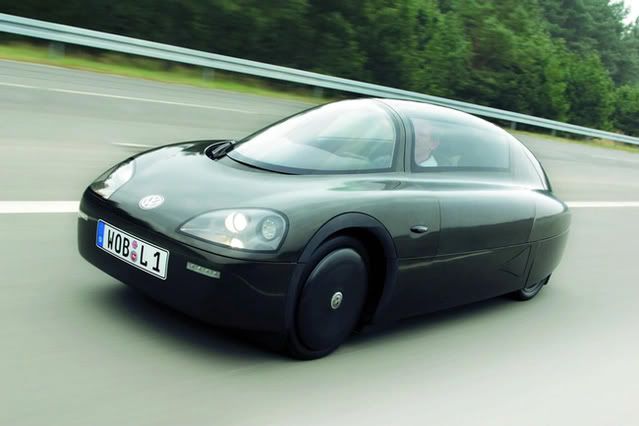
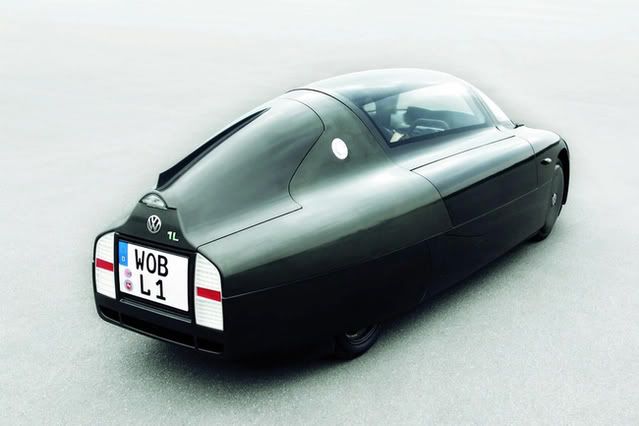

Volkswagen have decided to produce a limited run of a car very similar to their "one-litre" concept released in 2002, according to news on Car Magazine online. Production is likely to begin in 2010.
The original concept was capable of a staggering 282mpg, equivalent to the European measure of fuel consumption recording one litre of fuel for every 100km travelled (actually 0.99 litres but who's counting?), hence the name. The engine itself is rather less than one litre, displacing 299cc of pure diesel-fuelled economy and a less than headline-grabbing 8.5bhp. Thanks to the slippery aerodynamics and 300kg kerb weight, it can still hit around 75mph though it'll take a while to get there.
The production version is likely to use a more torquey and powerful twin cylinder turbodiesel engine, which will also provide more refinement than the single in the original concept. Just as well, considering magazines reported the original engine idled at 1400rpm and rattled to high heavens. Because of the change don't expect the same 282mpg of the original, but do expect it to be vastly more economical than any other production car available on the market.
According to Car, it's likely to be produced in limited numbers by Volkswagen's own prototype shop. The wait till 2010 has been necessary to let the price of producing the carbon monocoque fall, though don't expect the finished car to be available for less than €20,000 (£16,000) and it could be as high as €30,000 (£24,000). Due to the need for light weight you won't be getting much equipment with the car either, so until the concept is more economically viable (no pun intended) it's likely only to attract fairly well-off consumers, and probably a raft of headlines.
Well done to Volkswagen for going ahead with this project. Hopefully it will encourage other companies to follow suit and have the courage to produce cars that give out the message that clever technology and simple concepts are the way forward.
Images: Volkswagen



Subscribe to:
Posts (Atom)
copyright by AutoMotorPlex. Powered by Blogger.
